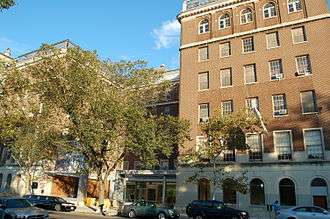El Museo del Barrio
 | |
| Established | 1969[1] |
|---|---|
| Location | 1230 Fifth Avenue, Museum Mile, New York, NY |
| Type | Art, Cultural |
| Director | J. Daniel Veneciano |
| Public transit access |
Subways: Buses: M3, M4, M102, M116 |
| Website | elmuseo.org |
El Museo del Barrio, often known simply as El Museo (the museum) is a museum located towards the northern end in the neighborhood of Museum Mile, immediately north of the Museum of the City of New York and south of the future Museum for African Art. Founded in 1969, El Museo specializes in Latin American and Caribbean art, with an emphasis on works from Puerto Rico and the Puerto Rican community in New York City.
Collection
The museum features an extensive collection of around 8,500[2] pieces composed of pre-Columbian and traditional artifacts, particularly a large permanent Taíno exhibit, as well as 20th century arts and crafts, graphics and popular media, Mexican masks, textiles from Chile and photographs and traditional art from Puerto Rico.[3] There are often temporary exhibits on Puerto Rican and Latino modern art. The museum also sponsors numerous festivals and educational programs throughout the year including the annual Three Kings Day parade. Due to a lack of space prior to their 2009-2010 expansion, the museum began to place some of their permanent collection online. This also served as a means of audience development.
Seeking to increase their audience and reach new audiences, El Museo has partnered with a number of organizations for joint exhibits including Nueva York (New York Historical Society)[4] and Caribbean Crossroads (Queens Museum of Art and the Studio Museum in Harlem).[5]
History
Originally, the museum was a Fire Station during the Nuyorican Movement and Civil Rights Movement, where books were burned by radical political figures. Spurred by concerns over a lack of cultural diversity in city educational programs[1] and educational opportunities in the barrio.[6] The group also included a number of parents, educators and community activists.[7] Artist/educator Rafael Montañez Ortíz[8] was enlisted to create materials for schools in East and Central Harlem that would highlight Puerto Rican art, history and culture. Ortiz reconceived this project as a community museum that would primarily function as a neighborhood institution serving Puerto Ricans in East Harlem. The museum also sought to define itself as an educational institution and its original location was a public school classroom.[7] With the increasing size of the Latino population throughout New York City, of which Puerto Ricans are still the majority, the scope of the museum has expanded, breeding conflict with some artists, scholars, and neighborhood activists anxious to preserve its original mission.
In 1977, El Museo joined the Cultural Institutions Group (also known as CIGs) which helped increase and maintain its funding.[7] Its funding was frozen in the 1980s following a period of mismanagement. However it was able to successfully rebound and grow. A Frida Kahlo exhibit in 2002 brought more attendees than normally visited the museum annually and helped to transform its perception and led to the museum's first non-Puerto Rican Director.[9]
On February 15, 2013, it was announced that Margarita Aguilar left her post as the director.[2]
Location
From El Museo's origins in a public school classroom,[7] it has called a number of different locations home. Between 1969 and 1976, it operated out of a number of different storefronts on Third and Lexington Avenues in the nexus of the community they served.[7] In 1977, they moved to their permanent home, the neo-classical Heckscher Building on Fifth Avenue and became a founding member of Museum Mile when it launched in 1978.[7] This location contributed to the museum's growth and audience development, increasing the market share of non Latino visitors to 40% of their audience.[7]
Expansion
In the early 2000s the museum experienced a significant increase in visitors, however remained confined to one floor in its building, which it shares with a school and a number of private organizations. A plan was proposed for the Museum of the City of New York, across the street from El Museo, to relocate to the historic Tweed Courthouse by City Hall in Lower Manhattan. El Museo would then have moved into the other museum's former building, dramatically expanding its available exhibition space. However, Mayor Michael Bloomberg decided to site the new New York City Department of Education in the Tweed Courthouse instead, frustrating the efforts of both museums.
After the failed relocation, El Museo opted to pursue a $15 million project to transform its outdoor courtyard into an open glass lobby, café and performance space, and to provide a suitable public "face" to the street on the model of the renovated Brooklyn Museum. It reopened following the renovation and expansion in October 2009 to mostly positive reviews. The renovation was spearheaded by NYC-based architect Gruzen Samton and completed at a cost of $35 million and added a shop and restaurant.[6]
See also
References
- 1 2 "EL MUSEO'S HISTORY | El Museo del Barrio New York". Elmuseo.org. 1970-07-30. Retrieved 2012-09-22.
- 1 2 "Amid Turmoil at Museo del Barrio, Its Director Steps Down". New York Times. Retrieved 16 February 2013.
- ↑ Archived May 15, 2010, at the Wayback Machine.
- ↑ "Nueva York". Nueva York. New-York Historical Society. Retrieved 2012-09-22.
- ↑ Coppola, John (2012-08-26). "Cultural Crossroads". Miami Herald. Retrieved 2012-09-22.
- 1 2 Mack, Joshua (2009-10-29). "New York's El Museo del Barrio reopens following expansion". artreview.com. Retrieved 2012-09-22.
- 1 2 3 4 5 6 7 "El Museo Del Barrio". El Museo Del Barrio. New York Architecture Images. Retrieved 2012-09-22.
- ↑ "Raphael Montañez Ortiz". Raphael Montañez Ortiz. Rutgers University. Retrieved 2012-09-22.
- ↑ Navarro, Mireya (2002-11-08). "El Museo Is Thinking Outside the Barrio; Incoming Leader Inherits Debate Over Museum's Cultural Mission". The New York Times. Retrieved 2012-09-22.
External links
Coordinates: 40°47′35″N 73°57′05″W / 40.793068°N 73.951378°W